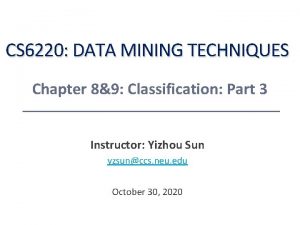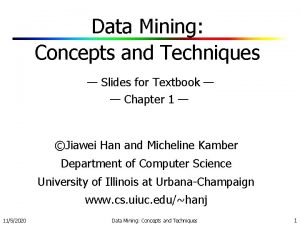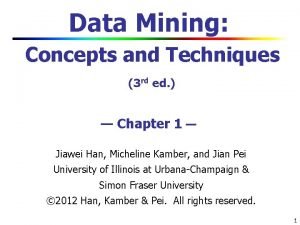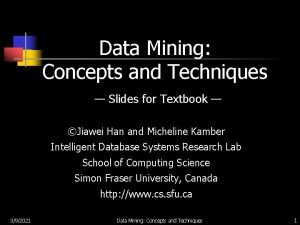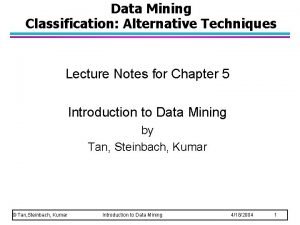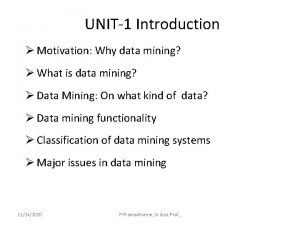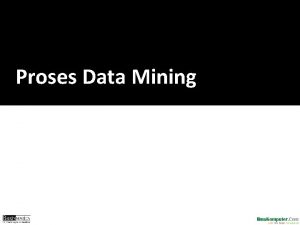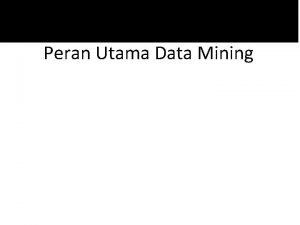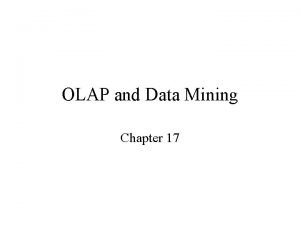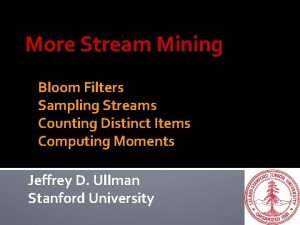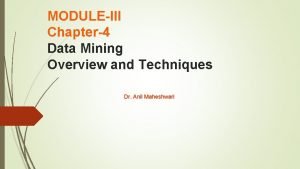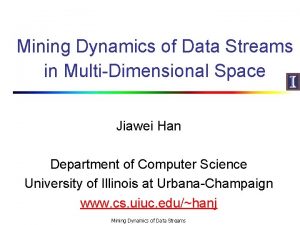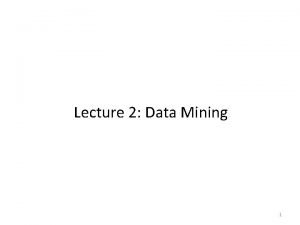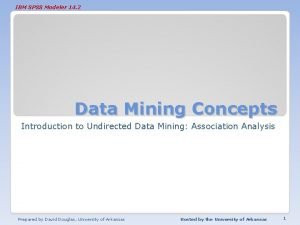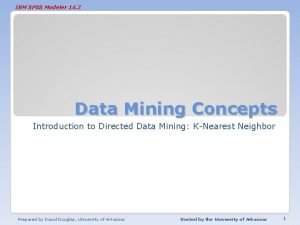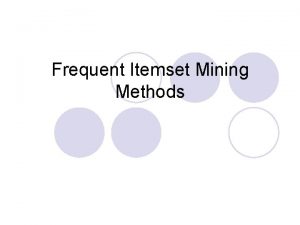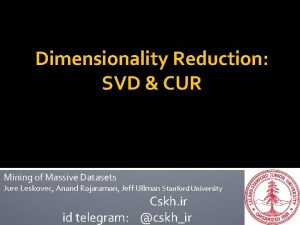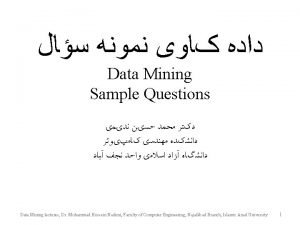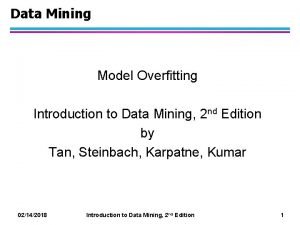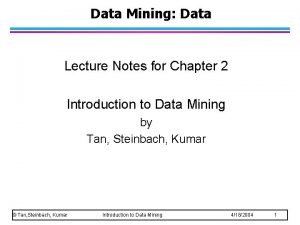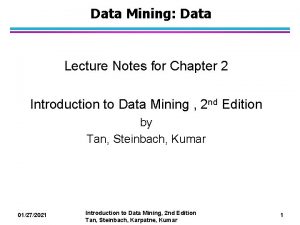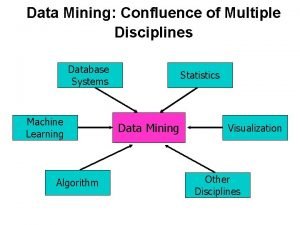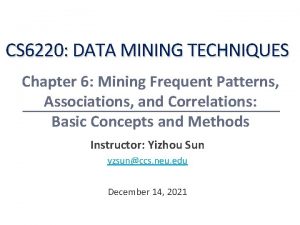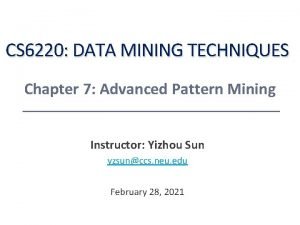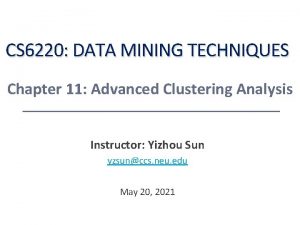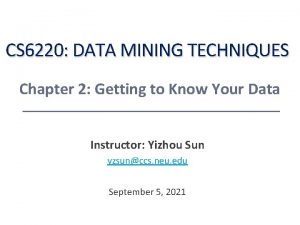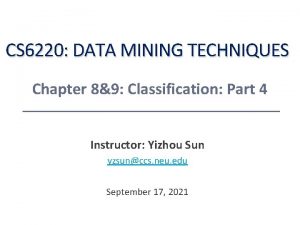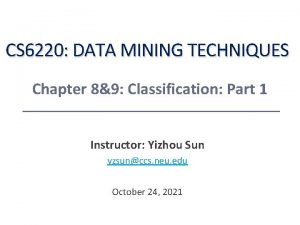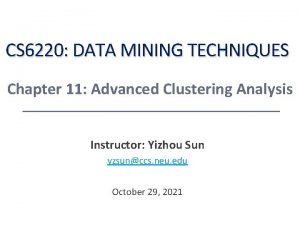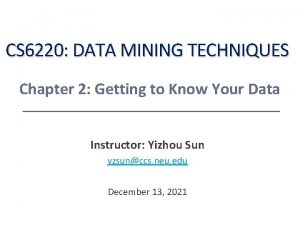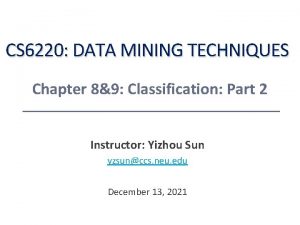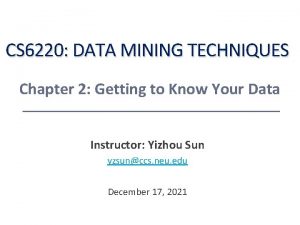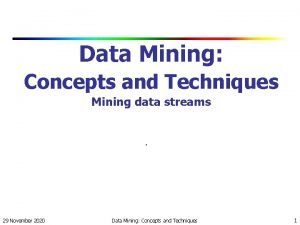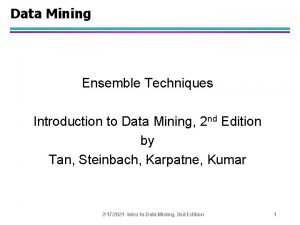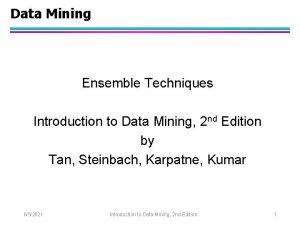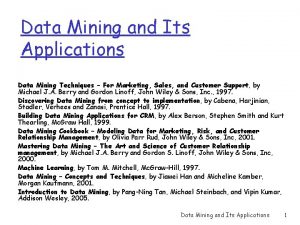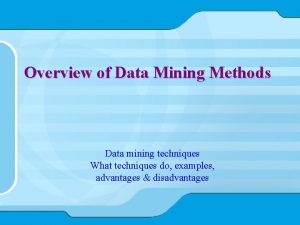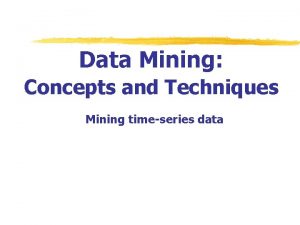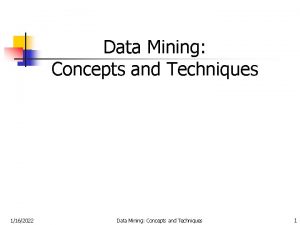CS 6220 DATA MINING TECHNIQUES Chapter 6 Mining



















































![Interestingness Measure: Correlations (Lift) • play basketball eat cereal [40%, 66. 7%] is misleading Interestingness Measure: Correlations (Lift) • play basketball eat cereal [40%, 66. 7%] is misleading](https://slidetodoc.com/presentation_image_h/2daee8a86ec7d428554380f36d51db98/image-52.jpg)













- Slides: 65

CS 6220: DATA MINING TECHNIQUES Chapter 6: Mining Frequent Patterns, Associations, and Correlations: Basic Concepts and Methods Instructor: Yizhou Sun yzsun@ccs. neu. edu March 8, 2021

Homework #1 • Textbook • P 80, 2. 3, 2. 4 • P 122, 3. 8 • P 274, 6. 6, 6. 14 2

Chapter 6: Mining Frequent Patterns, Association and Correlations • Basic Concepts • Frequent Itemset Mining Methods • Pattern Evaluation Methods • Summary 3

What Is Frequent Pattern Analysis? • Frequent pattern: a pattern (a set of items, subsequences, substructures, etc. ) that occurs frequently in a data set • First proposed by Agrawal, Imielinski, and Swami [AIS 93] in the context of frequent itemsets and association rule mining • Motivation: Finding inherent regularities in data • What products were often purchased together? — Beer and diapers? ! • What are the subsequent purchases after buying a PC? • What kinds of DNA are sensitive to this new drug? • Applications • Basket data analysis, cross-marketing, catalog design, sale campaign analysis, Web log (click stream) analysis, and DNA sequence analysis. 4

Why Is Freq. Pattern Mining Important? • Freq. pattern: An intrinsic and important property of datasets • Foundation for many essential data mining tasks • Association, correlation, and causality analysis • Sequential, structural (e. g. , sub-graph) patterns • Pattern analysis in spatiotemporal, multimedia, time-series, and stream data • Classification: discriminative, frequent pattern analysis • Cluster analysis: frequent pattern-based clustering • Broad applications 5

Basic Concepts: Frequent Patterns Tid Items bought 10 Beer, Nuts, Diaper 20 Beer, Coffee, Diaper 30 Beer, Diaper, Eggs 40 Nuts, Eggs, Milk 50 Nuts, Coffee, Diaper, Eggs, Milk Customer buys both Customer buys beer Customer buys diaper • itemset: A set of one or more items • k-itemset X = {x 1, …, xk} • (absolute) support, or, support count of X: Frequency or occurrence of an itemset X • (relative) support, s, is the fraction of transactions that contains X (i. e. , the probability that a transaction contains X) • An itemset X is frequent if X’s support is no less than a minsup threshold 6

Basic Concepts: Association Rules • Tid Items bought 10 Beer, Nuts, Diaper 20 Beer, Coffee, Diaper 30 Beer, Diaper, Eggs 40 50 Nuts, Eggs, Milk Nuts, Coffee, Diaper, Eggs, Milk Customer buys both Customer buys beer Customer buys diaper Find all the rules X Y with minimum support and confidence • support, s, probability that a transaction contains X Y • confidence, c, conditional probability that a transaction having X also contains Y Let minsup = 50%, minconf = 50% Freq. Pat. : Beer: 3, Nuts: 3, Diaper: 4, Eggs: 3, {Beer, Diaper}: 3 n Strong Association rules n Beer Diaper (60%, 100%) n Diaper Beer (60%, 75%) 7

Closed Patterns and Max-Patterns • A long pattern contains a combinatorial number of sub-patterns, e. g. , {a 1, …, a 100} contains 2100 – 1 = 1. 27*1030 sub-patterns! • Solution: Mine closed patterns and max-patterns instead • An itemset X is closed if X is frequent and there exists no super- pattern Y כ X, with the same support as X (proposed by Pasquier, et al. @ ICDT’ 99) • An itemset X is a max-pattern if X is frequent and there exists no frequent super-pattern Y כ X (proposed by Bayardo @ SIGMOD’ 98) • Closed pattern is a lossless compression of freq. patterns • Reducing the # of patterns and rules 8

Closed Patterns and Max-Patterns • Exercise. DB = {<a 1, …, a 100>, < a 1, …, a 50>} • Min_sup = 1. • What is the set of closed itemset? • <a 1, …, a 100>: 1 • < a 1, …, a 50>: 2 • What is the set of max-pattern? • <a 1, …, a 100>: 1 • What is the set of all patterns? • !! 9

Computational Complexity of Frequent Itemset Mining • How many itemsets are potentially to be generated in the worst case? • The number of frequent itemsets to be generated is sensitive to the minsup threshold • When minsup is low, there exist potentially an exponential number of frequent itemsets • The worst case: MN where M: # distinct items, and N: max length of transactions 10

• The worst case complexity vs. the expected probability • Ex. Suppose Walmart has 104 kinds of products • The chance to pick up one product 10 -4 • The chance to pick up a particular set of 10 products: ~10 -40 • What is the chance this particular set of 10 products to be frequent 103 times in 109 transactions? 11

Chapter 6: Mining Frequent Patterns, Association and Correlations • Basic Concepts • Frequent Itemset Mining Methods • Pattern Evaluation Methods • Summary 12

Scalable Frequent Itemset Mining Methods • Apriori: A Candidate Generation-and-Test Approach • Improving the Efficiency of Apriori • FPGrowth: A Frequent Pattern-Growth Approach • ECLAT: Frequent Pattern Mining with Vertical Data Format • Generating Association Rules 13

The Apriori Property and Scalable Mining Methods • The Apriori property of frequent patterns • Any nonempty subsets of a frequent itemset must be frequent • If {beer, diaper, nuts} is frequent, so is {beer, diaper} • i. e. , every transaction having {beer, diaper, nuts} also contains {beer, diaper} • Scalable mining methods: Three major approaches • Apriori (Agrawal & Srikant@VLDB’ 94) • Freq. pattern growth (FPgrowth—Han, Pei & Yin @SIGMOD’ 00) • Vertical data format approach (Eclat) 14

Apriori: A Candidate Generation & Test Approach • Apriori pruning principle: If there is any itemset which is infrequent, its superset should not be generated/tested! (Agrawal & Srikant @VLDB’ 94, Mannila, et al. @ KDD’ 94) • Method: • Initially, scan DB once to get frequent 1 -itemset • Generate length (k+1) candidate itemsets from length k frequent itemsets • Test the candidates against DB • Terminate when no frequent or candidate set can be generated 15

• From Frequent k-1 Itemset To Frequent k-Itemset 16

The Apriori Algorithm—An Example Database TDB Tid Items 10 A, C, D 20 B, C, E 30 A, B, C, E 40 B, E Supmin = 2 Itemset {A, C} {B, E} {C, E} sup {A} 2 {B} 3 {C} 3 {D} 1 {E} 3 C 1 1 st scan C 2 L 2 Itemset sup 2 2 3 2 Itemset {A, B} {A, C} {A, E} {B, C} {B, E} {C, E} sup 1 2 3 2 L 1 Itemset sup {A} 2 {B} 3 {C} 3 {E} 3 C 2 2 nd scan Itemset {A, B} {A, C} {A, E} {B, C} {B, E} {C, E} C 3 Itemset {B, C, E} 3 rd scan L 3 Itemset sup {B, C, E} 2 17

The Apriori Algorithm (Pseudo-Code) Ck: Candidate itemset of size k Lk : frequent itemset of size k L 1 = {frequent items}; for (k = 2; Lk-1 != ; k++) do begin Ck = candidates generated from Lk-1; for each transaction t in database do increment the count of all candidates in Ck+1 that are contained in t Lk+1 = candidates in Ck+1 with min_support end return k Lk; 18

Candidates Generation • 19

• Example of Candidate-generation from L 3 to C 4 • L 3={abc, abd, ace, bcd} • Self-joining: L 3*L 3 • abcd from abc and abd • acde from acd and ace • Pruning: • acde is removed because ade is not in L 3 • C 4 = {abcd} 20

The Apriori Algorithm—Example Review Database TDB Tid Items 10 A, C, D 20 B, C, E 30 A, B, C, E 40 B, E Supmin = 2 Itemset {A, C} {B, E} {C, E} sup {A} 2 {B} 3 {C} 3 {D} 1 {E} 3 C 1 1 st scan C 2 L 2 Itemset sup 2 2 3 2 Itemset {A, B} {A, C} {A, E} {B, C} {B, E} {C, E} sup 1 2 3 2 L 1 Itemset sup {A} 2 {B} 3 {C} 3 {E} 3 C 2 2 nd scan Itemset {A, B} {A, C} {A, E} {B, C} {B, E} {C, E} C 3 Itemset {B, C, E} 3 rd scan L 3 Itemset sup {B, C, E} 2 21

Questions • How many scans on DB are needed for Apriori algorithm? • When (k = ? ) does Apriori algorithm generate most candidate itemsets? • Is support counting for candidates expensive? 22

Scalable Frequent Itemset Mining Methods • Apriori: A Candidate Generation-and-Test Approach • Improving the Efficiency of Apriori • FPGrowth: A Frequent Pattern-Growth Approach • ECLAT: Frequent Pattern Mining with Vertical Data Format • Generating Association Rules 23

Further Improvement of the Apriori Method • Major computational challenges • Multiple scans of transaction database • Huge number of candidates • Tedious workload of support counting for candidates • Improving Apriori: general ideas • Reduce passes of transaction database scans • Shrink number of candidates • Facilitate support counting of candidates 24

Partition: Scan Database Only Twice • Any itemset that is potentially frequent in DB must be frequent in at least one of the partitions of DB • Scan 1: partition database and find local frequent patterns • Scan 2: consolidate global frequent patterns • A. Savasere, E. Omiecinski and S. Navathe, VLDB’ 95 DB 1 sup 1(i) < σDB 1 + DB 2 sup 2(i) < σDB 2 + + DBk supk(i) < σDBk = DB sup(i) < σDB

Hash-based Technique: Reduce the Number of Candidates • A k-itemset whose corresponding hashing bucket count is below the threshold cannot be frequent • {ab, ad, ae} • {bd, be, de} • … • Frequent 1 -itemset: a, b, d, e itemsets 35 88 {ab, ad, ae} {bd, be, de} . . . • Hash entries count 102 . . . • Candidates: a, b, c, d, e {yz, qs, wt} Hash Table • ab is not a candidate 2 -itemset if the sum of count of {ab, ad, ae} is below support threshold • J. Park, M. Chen, and P. Yu. An effective hash-based algorithm for mining association rules. SIGMOD’ 95 26

Sampling for Frequent Patterns • Select a sample of original database, mine frequent patterns within sample using Apriori • Scan database once to verify frequent itemsets found in sample, only borders of closure of frequent patterns are checked • Example: check abcd instead of ab, ac, …, etc. • Scan database again to find missed frequent patterns • H. Toivonen. Sampling large databases for association rules. In VLDB’ 96 27

Scalable Frequent Itemset Mining Methods • Apriori: A Candidate Generation-and-Test Approach • Improving the Efficiency of Apriori • FPGrowth: A Frequent Pattern-Growth Approach • ECLAT: Frequent Pattern Mining with Vertical Data Format • Generating Association Rules 28

Pattern-Growth Approach: Mining Frequent Patterns Without Candidate Generation • Bottlenecks of the Apriori approach • Breadth-first (i. e. , level-wise) search • Scan DB multiple times • Candidate generation and test • Often generates a huge number of candidates • The FPGrowth Approach (J. Han, J. Pei, and Y. Yin, SIGMOD’ 00) • Depth-first search • Avoid explicit candidate generation • Major philosophy: Grow long patterns from short ones using local frequent items only • “abc” is a frequent pattern • Get all transactions having “abc”, i. e. , project DB on abc: DB|abc • “d” is a local frequent item in DB|abc abcd is a frequent pattern 29

FP-Growth Algorithm Sketch • Construct FP-tree (frequent pattern-tree) • Compress the DB into a tree • Recursively mine FP-tree by FP-Growth • Construct conditional pattern base from FP-tree • Construct conditional FP-tree from conditional pattern base • Until the tree has a single path or empty 30

Construct FP-tree from a Transaction Database TID 100 200 300 400 500 Items bought (ordered) frequent items {f, a, c, d, g, i, m, p} {f, c, a, m, p} {a, b, c, f, l, m, o} {f, c, a, b, m} {b, f, h, j, o, w} {f, b} {b, c, k, s, p} {c, b, p} {a, f, c, e, l, p, m, n} {f, c, a, m, p} 1. Scan DB once, find frequent 1 -itemset (single item pattern) 2. Sort frequent items in frequency descending order, f-list 3. Scan DB again, construct FP-tree min_support = 3 {} Header Table Item frequency head f 4 c 4 a 3 b 3 m 3 p 3 F-list = f-c-a-b-m-p f: 4 c: 3 c: 1 b: 1 a: 3 b: 1 p: 1 m: 2 b: 1 p: 2 m: 1 31

Partition Patterns and Databases • Frequent patterns can be partitioned into subsets according to f-list • F-list = f-c-a-b-m-p • Patterns containing p • Patterns having m but no p • … • Patterns having c but no a nor b, m, p • Pattern f • Completeness and non-redundency 32

Find Patterns Having P From P-conditional Database • Starting at the frequent item header table in the FP-tree • Traverse the FP-tree by following the link of each frequent item p • Accumulate all of transformed prefix paths of item p to form p’s conditional pattern base {} Header Table Item frequency head f 4 c 4 a 3 b 3 m 3 p 3 f: 4 c: 3 c: 1 b: 1 a: 3 b: 1 p: 1 Conditional pattern bases item cond. pattern base c f: 3 a fc: 3 b fca: 1, f: 1, c: 1 m: 2 b: 1 m fca: 2, fcab: 1 p: 2 m: 1 p fcam: 2, cb: 1 33

From Conditional Pattern-bases to Conditional FP-trees • For each pattern-base • Accumulate the count for each item in the base • Construct the FP-tree for the frequent items of the pattern base Header Table Item frequency head f 4 c 4 a 3 b 3 m 3 p 3 m-conditional pattern base: fca: 2, fcab: 1 {} f: 4 c: 3 c: 1 b: 1 a: 3 b: 1 p: 1 {} f: 3 m: 2 b: 1 c: 3 p: 2 m: 1 a: 3 All frequent patterns relate to m m, fm, cm, am, fcm, fam, cam, fcam m-conditional FP-tree 34

Recursion: Mining Each Conditional FP-tree {} {} Cond. pattern base of “am”: (fc: 3) c: 3 f: 3 c: 3 a: 3 f: 3 am-conditional FP-tree Cond. pattern base of “cm”: (f: 3) {} f: 3 m-conditional FP-tree cm-conditional FP-tree {} Cond. pattern base of “cam”: (f: 3) f: 3 cam-conditional FP-tree 35

A Special Case: Single Prefix Path in FP-tree • Suppose a (conditional) FP-tree T has a shared single prefix -path P • Mining can be decomposed into two parts {} a 1: n 1 • Reduction of the single prefix path into one node • Concatenation of the mining results of the two parts a 2: n 2 a 3: n 3 b 1: m 1 C 2: k 2 r 1 {} C 1: k 1 C 3: k 3 r 1 = a 1: n 1 a 2: n 2 a 3: n 3 + b 1: m 1 C 2: k 2 C 1: k 1 C 3: k 3 36

Benefits of the FP-tree Structure • Completeness • Preserve complete information for frequent pattern mining • Never break a long pattern of any transaction • Compactness • Reduce irrelevant info—infrequent items are gone • Items in frequency descending order: the more frequently occurring, the more likely to be shared • Never be larger than the original database (not count node-links and the count field) 37

The Frequent Pattern Growth Mining Method • Idea: Frequent pattern growth • Recursively grow frequent patterns by pattern and database partition • Method • For each frequent item, construct its conditional pattern-base, and then its conditional FP-tree • Repeat the process on each newly created conditional FP-tree • Until the resulting FP-tree is empty, or it contains only one path —single path will generate all the combinations of its subpaths, each of which is a frequent pattern 38

Scaling FP-growth by Database Projection • What about if FP-tree cannot fit in memory? • DB projection • First partition a database into a set of projected DBs • Then construct and mine FP-tree for each projected DB • Parallel projection vs. partition projection techniques • Parallel projection • Project the DB in parallel for each frequent item • Parallel projection is space costly • All the partitions can be processed in parallel • Partition projection • Partition the DB based on the ordered frequent items • Passing the unprocessed parts to the subsequent partitions 39

FP-Growth vs. Apriori: Scalability With the Support Threshold Data set T 25 I 20 D 10 K 40

Advantages of the Pattern Growth Approach • Divide-and-conquer: • Decompose both the mining task and DB according to the frequent patterns obtained so far • Lead to focused search of smaller databases • Other factors • No candidate generation, no candidate test • Compressed database: FP-tree structure • No repeated scan of entire database • Basic ops: counting local freq items and building sub FP-tree, no pattern search and matching • A good open-source implementation and refinement of FPGrowth • FPGrowth+ (Grahne and J. Zhu, FIMI'03) 41

Further Improvements of Mining Methods • AFOPT (Liu, et al. @ KDD’ 03) • A “push-right” method for mining condensed frequent pattern (CFP) tree • Carpenter (Pan, et al. @ KDD’ 03) • Mine data sets with small rows but numerous columns • Construct a row-enumeration tree for efficient mining • FPgrowth+ (Grahne and Zhu, FIMI’ 03) • Efficiently Using Prefix-Trees in Mining Frequent Itemsets, Proc. ICDM'03 Int. Workshop on Frequent Itemset Mining Implementations (FIMI'03), Melbourne, FL, Nov. 2003 • TD-Close (Liu, et al, SDM’ 06) 42

Extension of Pattern Growth Mining Methodology • Mining closed frequent itemsets and max-patterns • CLOSET (DMKD’ 00), FPclose, and FPMax (Grahne & Zhu, Fimi’ 03) • Mining sequential patterns • Prefix. Span (ICDE’ 01), Clo. Span (SDM’ 03), BIDE (ICDE’ 04) • Mining graph patterns • g. Span (ICDM’ 02), Close. Graph (KDD’ 03) • Constraint-based mining of frequent patterns • Convertible constraints (ICDE’ 01), g. Prune (PAKDD’ 03) • Computing iceberg data cubes with complex measures • H-tree, H-cubing, and Star-cubing (SIGMOD’ 01, VLDB’ 03) • Pattern-growth-based Clustering • Ma. Ple (Pei, et al. , ICDM’ 03) • Pattern-Growth-Based Classification • Mining frequent and discriminative patterns (Cheng, et al, ICDE’ 07) 43

Scalable Frequent Itemset Mining Methods • Apriori: A Candidate Generation-and-Test Approach • Improving the Efficiency of Apriori • FPGrowth: A Frequent Pattern-Growth Approach • ECLAT: Frequent Pattern Mining with Vertical Data Format • Generating Association Rules 44

ECLAT: Mining by Exploring Vertical Data Format • Vertical format: t(AB) = {T 11, T 25, …} • tid-list: list of trans. -ids containing an itemset • Deriving frequent patterns based on vertical intersections • t(X) = t(Y): X and Y always happen together • t(X) t(Y): transaction having X always has Y • Using diffset to accelerate mining • Only keep track of differences of tids • t(X) = {T 1, T 2, T 3}, t(XY) = {T 1, T 3} • Diffset (XY, X) = {T 2} • Eclat (Zaki et al. @KDD’ 97) 45

Scalable Frequent Itemset Mining Methods • Apriori: A Candidate Generation-and-Test Approach • Improving the Efficiency of Apriori • FPGrowth: A Frequent Pattern-Growth Approach • ECLAT: Frequent Pattern Mining with Vertical Data Format • Generating Association Rules 46

Generating Association Rules • 47

Example • 48

Chapter 6: Mining Frequent Patterns, Association and Correlations • Basic Concepts • Frequent Itemset Mining Methods • Pattern Evaluation Methods • Summary 49

Misleading Strong Association Rules • Not all strong association rules are interesting Basketball Not basketball Sum (row) Cereal 2000 1750 3750 Not cereal 1000 250 1250 Sum(col. ) 3000 2000 5000 play basketball eat cereal [40%, 66. 7%] • Shall we target people who play basketball for cereal ads? • Hint: What is the overall probability of people who eat cereal? • 3750/5000 = 75% > 66. 7%! • Confidence measure of a rule could be misleading 50

Other Measures • 51
![Interestingness Measure Correlations Lift play basketball eat cereal 40 66 7 is misleading Interestingness Measure: Correlations (Lift) • play basketball eat cereal [40%, 66. 7%] is misleading](https://slidetodoc.com/presentation_image_h/2daee8a86ec7d428554380f36d51db98/image-52.jpg)
Interestingness Measure: Correlations (Lift) • play basketball eat cereal [40%, 66. 7%] is misleading • The overall % of students eating cereal is 75% > 66. 7%. • play basketball not eat cereal [20%, 33. 3%] is more accurate, although with lower support and confidence • Measure of dependent/correlated events: lift Basketball Not basketball Sum (row) Cereal 2000 1750 3750 Not cereal 1000 250 1250 Sum(col. ) 3000 2000 52

Correlation Analysis (Nominal Data) • 53

• Are lift and 2 Good Measures of Correlation? 54

Comparison of Interestingness Measures • Null-(transaction) invariance is crucial for correlation analysis • Lift and 2 are not null-invariant • 5 null-invariant measures Milk No Milk Sum (row) Coffee m, c ~m, c c No Coffee m, ~c ~c Sum(col. ) m ~m Null-transactions w. r. t. m and c March 8, 2021 Kulczynski measure (1927) Null-invariant Data. Subtle: Mining: Concepts Techniques 55 Theyand disagree

Analysis of DBLP Coauthor Relationships Recent DB conferences, removing balanced associations, low sup, etc. Advisor-advisee relation: Kulc: high, coherence: low, cosine: middle • Tianyi Wu, Yuguo Chen and Jiawei Han, “Association Mining in Large Databases: A Re-Examination of Its Measures”, Proc. 2007 Int. Conf. Principles and Practice of Knowledge Discovery in Databases (PKDD'07), Sept. 2007 56

Which Null-Invariant Measure Is Better? • IR (Imbalance Ratio): measure the imbalance of two itemsets A and B in rule implications • Kulczynski and Imbalance Ratio (IR) together present a clear picture for all the three datasets D 4 through D 6 • D 4 is balanced & neutral • D 5 is imbalanced & neutral • D 6 is very imbalanced & neutral

Chapter 6: Mining Frequent Patterns, Association and Correlations • Basic Concepts • Frequent Itemset Mining Methods • Pattern Evaluation Methods • Summary 58

Summary Basic concepts • Frequent pattern, association rules, support-confident framework, closed and max-patterns • Scalable frequent pattern mining methods • • Apriori • FPgrowth • Vertical format approach (ECLAT) Which patterns are interesting? • • Pattern evaluation methods 59

Ref: Basic Concepts of Frequent Pattern Mining • (Association Rules) R. Agrawal, T. Imielinski, and A. Swami. Mining association rules between sets of items in large databases. SIGMOD'93. • (Max-pattern) R. J. Bayardo. Efficiently mining long patterns from databases. SIGMOD'98. • (Closed-pattern) N. Pasquier, Y. Bastide, R. Taouil, and L. Lakhal. Discovering frequent closed itemsets for association rules. ICDT'99. • (Sequential pattern) R. Agrawal and R. Srikant. Mining sequential patterns. ICDE'95 60

Ref: Apriori and Its Improvements • R. Agrawal and R. Srikant. Fast algorithms for mining association rules. VLDB'94. • H. Mannila, H. Toivonen, and A. I. Verkamo. Efficient algorithms for discovering association rules. KDD'94. • A. Savasere, E. Omiecinski, and S. Navathe. An efficient algorithm for mining association rules in large databases. VLDB'95. • J. S. Park, M. S. Chen, and P. S. Yu. An effective hash-based algorithm for mining association rules. SIGMOD'95. • H. Toivonen. Sampling large databases for association rules. VLDB'96. • S. Brin, R. Motwani, J. D. Ullman, and S. Tsur. Dynamic itemset counting and implication rules for market basket analysis. SIGMOD'97. • S. Sarawagi, S. Thomas, and R. Agrawal. Integrating association rule mining with relational database systems: Alternatives and implications. SIGMOD'98. 61

Ref: Depth-First, Projection-Based FP Mining • R. Agarwal, C. Aggarwal, and V. V. V. Prasad. A tree projection algorithm for generation of frequent itemsets. J. Parallel and Distributed Computing: 02. • J. Han, J. Pei, and Y. Yin. Mining frequent patterns without candidate generation. SIGMOD’ 00. • J. Liu, Y. Pan, K. Wang, and J. Han. Mining Frequent Item Sets by Opportunistic Projection. KDD'02. • J. Han, J. Wang, Y. Lu, and P. Tzvetkov. Mining Top-K Frequent Closed Patterns without Minimum Support. ICDM'02. • J. Wang, J. Han, and J. Pei. CLOSET+: Searching for the Best Strategies for Mining Frequent Closed Itemsets. KDD'03. • G. Liu, H. Lu, W. Lou, J. X. Yu. On Computing, Storing and Querying Frequent Patterns. KDD'03. • G. Grahne and J. Zhu, Efficiently Using Prefix-Trees in Mining Frequent Itemsets, Proc. ICDM'03 Int. Workshop on Frequent Itemset Mining Implementations (FIMI'03), Melbourne, FL, Nov. 2003 62

Ref: Vertical Format and Row Enumeration Methods • M. J. Zaki, S. Parthasarathy, M. Ogihara, and W. Li. Parallel algorithm for discovery of association rules. DAMI: 97. • Zaki and Hsiao. CHARM: An Efficient Algorithm for Closed Itemset Mining, SDM'02. • C. Bucila, J. Gehrke, D. Kifer, and W. White. Dual. Miner: A Dual-Pruning Algorithm for Itemsets with Constraints. KDD’ 02. • F. Pan, G. Cong, A. K. H. Tung, J. Yang, and M. Zaki , CARPENTER: Finding Closed Patterns in Long Biological Datasets. KDD'03. • H. Liu, J. Han, D. Xin, and Z. Shao, Mining Interesting Patterns from Very High Dimensional Data: A Top-Down Row Enumeration Approach, SDM'06. 63

Ref: Mining Correlations and Interesting Rules • M. Klemettinen, H. Mannila, P. Ronkainen, H. Toivonen, and A. I. Verkamo. Finding interesting rules from large sets of discovered association rules. CIKM'94. • S. Brin, R. Motwani, and C. Silverstein. Beyond market basket: Generalizing association rules to correlations. SIGMOD'97. • C. Silverstein, S. Brin, R. Motwani, and J. Ullman. Scalable techniques for mining causal structures. VLDB'98. • P. -N. Tan, V. Kumar, and J. Srivastava. Selecting the Right Interestingness Measure for Association Patterns. KDD'02. • E. Omiecinski. Alternative Interest Measures for Mining Associations. TKDE’ 03. • T. Wu, Y. Chen and J. Han, “Association Mining in Large Databases: A Re. Examination of Its Measures”, PKDD'07 64

Ref: Freq. Pattern Mining Applications • Y. Huhtala, J. Kärkkäinen, P. Porkka, H. Toivonen. Efficient Discovery of Functional and Approximate Dependencies Using Partitions. ICDE’ 98. • H. V. Jagadish, J. Madar, and R. Ng. Semantic Compression and Pattern Extraction with Fascicles. VLDB'99. • T. Dasu, T. Johnson, S. Muthukrishnan, and V. Shkapenyuk. Mining Database Structure; or How to Build a Data Quality Browser. SIGMOD'02. • K. Wang, S. Zhou, J. Han. Profit Mining: From Patterns to Actions. EDBT’ 02. 65
 Cs 6220
Cs 6220 Mining complex types of data
Mining complex types of data Mining multimedia databases in data mining
Mining multimedia databases in data mining Data mining confluence of multiple disciplines
Data mining confluence of multiple disciplines Function of data mining
Function of data mining Data mining concepts and techniques slides
Data mining concepts and techniques slides Data mining concepts and techniques slides
Data mining concepts and techniques slides Binning techniques in data mining
Binning techniques in data mining Association data mining techniques
Association data mining techniques Classification alternative techniques in data mining
Classification alternative techniques in data mining Data reduction in data mining
Data reduction in data mining What is data mining and data warehousing
What is data mining and data warehousing What is missing data in data mining
What is missing data in data mining Data reduction in data mining
Data reduction in data mining Data reduction in data mining
Data reduction in data mining Data reduction in data mining
Data reduction in data mining Data cube technology in data mining
Data cube technology in data mining Data reduction in data mining
Data reduction in data mining Arsitektur data mining
Arsitektur data mining Data mining dan data warehouse
Data mining dan data warehouse Crm data warehouse models
Crm data warehouse models Mining complex types of data
Mining complex types of data Olap database
Olap database Noisy data in data mining
Noisy data in data mining Three tier data warehouse
Three tier data warehouse Data preparation for data mining
Data preparation for data mining Data compression in data mining
Data compression in data mining Introduction to data warehousing and data mining
Introduction to data warehousing and data mining Data warehouse dan data mining
Data warehouse dan data mining Cs 412 introduction to data mining
Cs 412 introduction to data mining Strip mining vs open pit mining
Strip mining vs open pit mining Chapter 13 mineral resources and mining
Chapter 13 mineral resources and mining Difference between strip mining and open pit mining
Difference between strip mining and open pit mining Web text mining
Web text mining Fonctions techniques et solutions techniques
Fonctions techniques et solutions techniques Unsupervised learning in data mining
Unsupervised learning in data mining Motivation for data mining
Motivation for data mining Reporting and query tools in data mining
Reporting and query tools in data mining Pump it up: data mining the water table
Pump it up: data mining the water table Sebutkan tahapan utama proses data mining
Sebutkan tahapan utama proses data mining Sebutkan 5 peran utama data mining
Sebutkan 5 peran utama data mining Olap stands for *
Olap stands for * Bloom filter for stream data mining
Bloom filter for stream data mining What are the steps in mining process?
What are the steps in mining process? Data mining exam
Data mining exam Multidimensional space in data mining
Multidimensional space in data mining Data mining roadmap
Data mining roadmap Pentaho weka
Pentaho weka Spatial data mining applications
Spatial data mining applications Walmart data mining
Walmart data mining Data mining spss
Data mining spss Spss 14
Spss 14 Apriori algorithm
Apriori algorithm Gini index
Gini index Emr data mining
Emr data mining Cur decomposition in data mining
Cur decomposition in data mining Dss in data mining
Dss in data mining Mining
Mining Overfitting in data mining
Overfitting in data mining Svd data mining
Svd data mining Data mining lectures
Data mining lectures Data mining functionalities
Data mining functionalities Collection of data objects
Collection of data objects Correlation data mining
Correlation data mining Dimensionality reduction
Dimensionality reduction Confluence of multiple disciplines in data mining
Confluence of multiple disciplines in data mining
